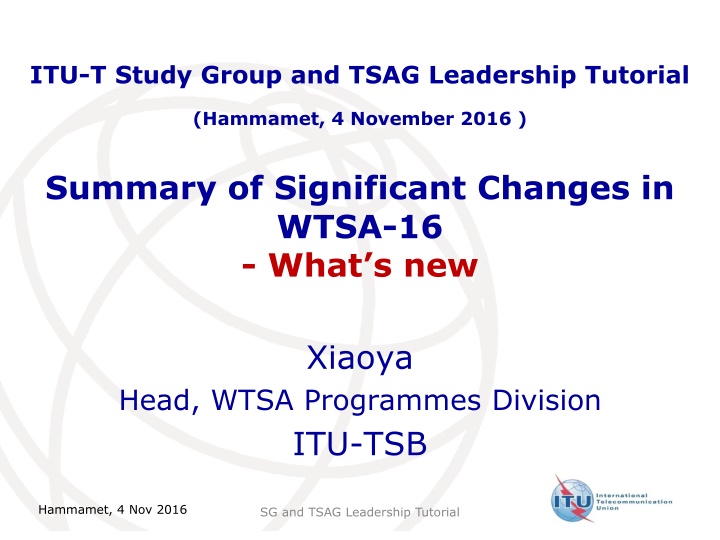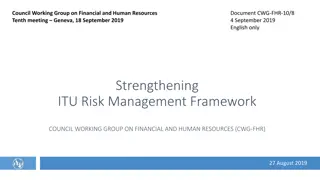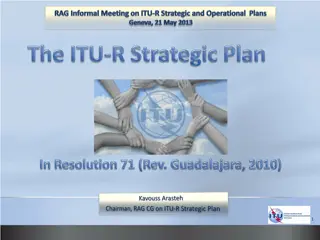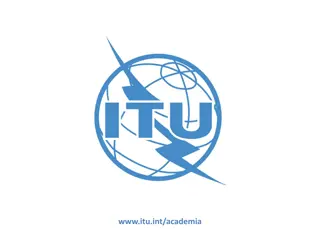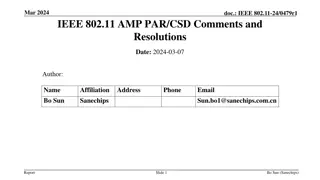Significant Changes in ITU-T WTSA-16: Overview of Resolutions and Recommendations
The ITU-T Study Group and TSAG Leadership Tutorial in Hammamet on 4th November 2016 discussed significant changes in WTSA-16, highlighting new resolutions, suppressed resolutions, and modifications in ITU-T recommendations. There were important updates in various areas such as IXP, UnivSer, IMR, SMP, and NGN. The tutorial also covered the resolutions in force, resolutions/opinions unchanged, and practical applications of network externality premium. Overall, the event focused on enhancing coordination and cooperation among ITU sectors and addressing emerging challenges in telecommunications.
Download Presentation

Please find below an Image/Link to download the presentation.
The content on the website is provided AS IS for your information and personal use only. It may not be sold, licensed, or shared on other websites without obtaining consent from the author.If you encounter any issues during the download, it is possible that the publisher has removed the file from their server.
You are allowed to download the files provided on this website for personal or commercial use, subject to the condition that they are used lawfully. All files are the property of their respective owners.
The content on the website is provided AS IS for your information and personal use only. It may not be sold, licensed, or shared on other websites without obtaining consent from the author.
E N D
Presentation Transcript
ITU-T Study Group and TSAG Leadership Tutorial (Hammamet, 4 November 2016 ) Summary of Significant Changes in WTSA-16 - What s new Xiaoya Head, WTSA Programmes Division ITU-TSB Hammamet, 4 Nov 2016 SG and TSAG Leadership Tutorial
Overview 1. Resolutions 2. Modifications in ITU-T A-series Recommendations 3. ITU-T D-series Recommendations D.52 (IXP), D.53(UnivSer), D.97(IMR), D.261(SMP), D.271(NGN) 2 SG and TSAG Leadership Tutorial Hammamet, 4 Nov 2016
WTSA Resolutions in force 61 in total WTSA-12 Resolutions/Opinion Unchanged (14) New Resolutions adopted in WTSA-16 (16) WTSA-12 Resolutions editorially changed (6) (substantively) revised (25) 1. 2. 3. 1. 2. Note: WTSA-12 Resolutions suppressed by WTSA-16 (6) 3 Hammamet, 4 Nov 2016 SG and TSAG Leadership Tutorial
Suppressed Resolutions Resolution 33 Guidelines for ITU-T strategic activities Resolution 38 Coordination among ITU-T, ITU- R and ITU-D for activities relating to IMT Resolution 57 Strengthening coordination and cooperation among ITU R, ITU T and ITU D on matters of mutual interest Resolution 71 Admission of academia to participate in the work of ITU-T Resolution 81 Strengthening collaboration Resolution 82 Strategic and structural review 1. 2. 3. 4. 5. 6. 4 SG and TSAG Leadership Tutorial Hammamet, 4 Nov 2016
Resolutions/Opinion unchanged Resolution 31 Admission of Associates in the work of ITU-T Resolution 34 Voluntary Contributions Resolution 43 Regional preparation for WTSAs Resolution 47 Country code top-level domain names Resolution 48 Internationalized (multilingual) domain names Resolution 58 national CIRTs, particularly for developing countries Resolution 59 Enhancing participation of telecommunication operators from developing countries Resolution 60 evolution of the identification/numbering system and its convergence with IP-based systems/networks Resolution 61 Countering and combating misappropriation and misuse of international telecommunication numbering resources Resolution 62 Dispute settlement Resolution 66 Technology Watch in TSB Resolution 74 Sector Members from developing countries in ITU-T Resolution 79 e-waste Opinion 1 Practical application of network externality premium 1. 2. 3. 4. 5. 6. 7. 8. 9. 10. 11. 12. 13. 14. 5 SG and TSAG Leadership Tutorial Hammamet, 4 Nov 2016
WTSA Resolutions with editorial modifications only 1. Resolution 20, Procedures for allocation and management of international telecommunication numbering, naming, addressing and identification (NNAI) resources 2. Resolution 40, Regulatory aspects of ITU-T work 3. Resolution 49, ENUM 4. Resolution 54, Creation and assistance to regional groups 5. Resolution 69, Non-discriminatory access and use of Internet resources 6. Resolution 78, e-health 6 Hammamet, 4 Nov 2016 SG and TSAG Leadership Tutorial
New Resolutions [COM3/1] Evaluation implementation of WTSA Resolutions [COM4/1] - Cloud based event data technology [COM4/2] - Protection of users of telecommunication/ICT services [COM4/3] - Enhancing the non-radio aspects related standardization activities in ITU-T on international mobile telecommunications [COM4/4] - International mobile roaming (IMR) [COM4/5] - Enhancing access to an electronic repository of information on numbering plans published by ITU-T [COM4/6] - Interconnection of 4G, IMT-2020 networks and beyond [COM4/7] -Promoting use of ICTs to bridge financial inclusion gap [COM4/8] - Strengthening and diversifying ITU-T resources 7 SG and TSAG Leadership Tutorial Hammamet, 4 Nov 2016
New Resolutions [COM4/9] - Facilitating implementation of Smart Africa Manifesto [COM4/10] - Enhancing the standardization of Internet of Things and Smart Cities & Communities for global development [COM4/11] - ITU-T initiatives to raise awareness on best practices and policies related to service quality [COM4/12] ITU-T participation in periodic review and revision of ITRs [PLEN/1] ITU-T studies for combating counterfeit telecommunication/ICT devices [PLEN/2] Combating mobile telecommunication device theft [PLEN/3] Open source in ITU-T 8 SG and TSAG Leadership Tutorial Hammamet, 4 Nov 2016
New Resolutions 9 SG and TSAG Leadership Tutorial Hammamet, 4 Nov 2016
[COM3/1] Evaluation of the implementation of WTSA Resolutions invite Member States and Sector Members to develop a state of their implementation of the Resolutions to next WTSA; to propose how to improve the implementation of Resolutions, instructs TSB Director, in collaboration with other Directors, to assess WTSA Resolutions implementation by all parties, instructs TSB Director to take account of the implementation of WTSA Resolutions and submit an assessment report to TSAG. 1. 2. 10 Hammamet, 4 Nov 2016 SG and TSAG Leadership Tutorial
[COM4/1] Standardization work in ITU-T for cloud based event data technology instruct ITU-T SG 13, 16, 17 and 20 to evaluate existing, evolving and new recommendations; to make recommendations to TSAG on how to address the topics outside their mandate instruct TSAG drive a concerted effort across relevant SGs instruct TSB Director provide necessary assistance to speed up this work and to encourage participation & contributions from developing countries Organize workshop(s) to collect requirements and input invites Member States, Sector Members, Associates and academia to submit contributions 1. 2. 11 Hammamet, 4 Nov 2016 SG and TSAG Leadership Tutorial
[COM4/2] Studies concerning protection of users of telecommunication/ICT services ITU-T SG 3, with ITU-T SG 2, 12 and 17, to carry out studies including standards Invites Member States consider creation of an enabling environment in which telecommunication operators can provide telecommunication/ICT services for their users, with the appropriate quality, level of confidence and security, and stimulating competitive, fair and affordable prices, and in order in general to protect users of telecommunication/ICT services invites Member States, Sector Members, Associates and Academia Contribute and collaborate on implementing this Resolution 12 Hammamet, 4 Nov 2016 SG and TSAG Leadership Tutorial
[COM4/3] Enhancing non-radio aspects related standardization activities in ITU-T on international mobile telecommunications TSAG to coordinate among ITU-T SGs, encourage collaboration with other SDOs ITU-T SGs to report annually in ITU-T s standard strategy on IMT SG 13 to maintain roadmap of IMT, establish JCA IMT-2020 SG 15 to promote studies on IMT s fronthaul and backhaul network standardization activities SG 11 to promote studies on non-radio aspects of IMT s signalling, protocol and testing SG 12 to promote studies on non-radio aspects of IMT service, QoS and QoE SG 17 to promote studies on IMT network and applications security 13 Hammamet, 4 Nov 2016 SG and TSAG Leadership Tutorial
[COM4/4] International mobile roaming (IMR) ITU-T SG3 to continue study economic effects of IMR rates TSB Director to organize awareness-raising initiatives on the consumer s benefits of lowering IMR rates propose cooperative implementation of ITU-T D.98 and D.97, and to lower IMR rates, by promoting capacity building programs, workshops and guidelines for international cooperation agreements invites Member States to implement ITU-T D.98 and D.97; collaborate in lowering IMR rates by taking regulatory measures 1. 2. 14 Hammamet, 4 Nov 2016 SG and TSAG Leadership Tutorial
[COM4/5] Enhancing access to an electronic repository of information on numbering plans published by ITU-T ITU-T SG2 to study the requirement of electronic access to a repository of numbering resources reserved, assigned or allocated to each operator/service provider within every country, including E.164 national numbering plans based on ITU-T E.129, and international numbering resources assigned by TSB Director then, TSB Director to organize and maintain such an electronic repository, within the allocated budget Invite Member States to make available information on the presentation of their national numbering plans and amendments thereto in a timely manner 15 Hammamet, 4 Nov 2016 SG and TSAG Leadership Tutorial
[COM4/6] Interconnection of 4G, IMT-2020 networks and beyond TSB Director to identify and prioritize problems related to achieving interconnection of IP-based networks such as IMT2020 and beyond Report to Council ITU-T SG11 to develop ITU-T Recommendations which specify the framework and signalling architectures for Interconnection of 4G, IMT-2020 networks and beyond ITU-T SG2 to develop ITU-T Recommendations which specify the ENUM architecture, including administrative control related to international telecommunication resources Hammamet, 4 Nov 2016 SG and TSAG Leadership Tutorial 16
[COM4/7] Promoting the use of ICTs to bridge the financial inclusion gap Resolves Further develop existing ITU-T Work Programme on DFS (esp in SG 2 and 3) Conduct studies and develop standards and guidelines in the areas of interoperability, digitization of payments, consumer protection, quality of service, big data and security of DFS transactions (TSB and SGs) encourage collaboration between telecommunication regulators and financial services authorities (TSB) Relevant SGs to initiate new work on DFS in next study period (SG2, 3, 12 and 17) + collaborate with other SDOs 17 Hammamet, 4 Nov 2016 SG and TSAG Leadership Tutorial
[COM4/7] Promoting the use of ICTs to bridge the financial inclusion gap continue TSB Director in collaboration with BDT and BR Directors Report annually to Council and WTSA-2020 on implementation of Res. Develop reports and best practices on DFS Set up a platform for peer learning and sharing of experience (based on FG DFS participants) Organize workshops Invite Member States Develop national strategies to address digital financial inclusion as priority Implement reforms to reduce the gender gap in access to financial services Enhance coordination to create level playing field for banks and non banks 18 Hammamet, 4 Nov 2016 SG and TSAG Leadership Tutorial
[COM4/8] Strengthening and diversifying ITU-T resources resolves to instruct TSB Director 1 to study for possible new measures to generate additional revenue for ITU-T, including revenues that may be obtained from INRs and C&I testing. 19 Hammamet, 4 Nov 2016 SG and TSAG Leadership Tutorial
[COM4/9] Facilitating implementation of Smart Africa Manifesto TSB Director to establish mechanisms for collaboration and cooperation between ITU-T SGs and Smart Africa office in development of standards to provide assistance to Smart Africa and Africa Regional Groups pilot projects of implementation of ITU standards; to strengthen trainings and guide Smart Africa member states, partner industries and organizations in their adoption of ITU-T s standards 20 Hammamet, 4 Nov 2016 SG and TSAG Leadership Tutorial
[COM4/10] Enhancing the standardization of Internet of Things and Smart Cities & Communities for global development ITU-T SG20 to develop ITU-T Recommendations, roadmap aimed at implementing IoT and SC&C on issues related to emerging technologies and vertical industries collate, evaluate, assess and share IoT use cases for interoperability and standardization for data and information exchange TSB Director to carry out pilot projects in cities related to the SC&C KPI assessment activities continue to support the United for Smart Sustainable Cities Initiative (U4SSC) 21 Hammamet, 4 Nov 2016 SG and TSAG Leadership Tutorial
[COM4/11] ITU-T initiatives to raise awareness on best practices and policies related to service quality ITU-T to develop Recommendations on performance, QoS and QoE develop initiatives to raise awareness to inform users operators QoS provide references for national quality measurement framework organize workshops, training programmes TSB Director to continue support Quality of Service Development Group conduct activities in each region ITU-T SGs elaborate recommendations in defining strategies and testing methodologies to monitor and measure QoS and QoE Study QoS and QoE evaluation scenarios, measurement strategies and testing tools, sampling methodologies for quality of service measurements at a local, national and global level references about minimal satisfactory key performance and key quality indicators for evaluating QoS Raise participation from all regions 22 Hammamet, 4 Nov 2016 SG and TSAG Leadership Tutorial
[COM4/12] ITU-T Participation in periodic review and revision of ITRs recognizing a) Telecommunication Standardization Sector (ITU-T) has most of the work relevant to the ITRs, b) the importance of ITU-T study groups input to the contributory process of the Standardization Sector to the EG-ITRs, as appropriate and where necessary. resolves to instruct TSB Director to undertake the necessary activities within his field of competencein order to fully implement PP Resolution 146 and Council Resolution 1379; to submit the result of his work to the EG-ITRs, instructs TSAG to provide advice to TSB Director; invites Member States and Sector Members to participate in and contribute to the implementation of this Resolution that, as is stated in Resolution 146, the ITU 1. 2. 23 SG and TSAG Leadership Tutorial Hammamet, 4 Nov 2016
[PLEN/1] ITU-T studies for combating counterfeit telecommunication/ICT devices ITU-T SG11 be the lead study group study existing/new reliable, unique, persistent and secure identifiers, in collaboration with ITU-T SG 2, 17 and 20, that have the potential to be used, including their scope of application and level of security in the context of their possible duplication/cloning; to develop methods of assessing and verifying identifiers used for purposes of ; develop mechanisms for identifying production, unique identifiers study possible solutions/frameworks to discover identity management information identify a list of technologies/products, used for testing conformance with ITU-T Recommendations 24 Hammamet, 4 Nov 2016 SG and TSAG Leadership Tutorial
[PLEN/2] Combating mobile telecommunication device theft ITU-T to develop solutions to duplication of unique identifiers ITU-T SG11 to lead the combat against mobile telecommunication device theft ITU-T SG11 and 17 to study draw up a list of identifiers used in mobile telecommunication/ICT device TSB Director compile best practices facilitate standardization, specifically regarding the exchange of identifier of mobile devices reported stolen or lost, and to prevent lost or stolen mobile devices from accessing mobile networks Consult to identify existing and future technological measures Provide assistance to Member States upon request 25 Hammamet, 4 Nov 2016 SG and TSAG Leadership Tutorial
[PLEN/3] Open Source in ITU-T resolves TSAG continue to work on benefits and disadvantages of implementation of open- source projects in relation with ITU-T work continue fulfilling of the outcomes of TSAG Report 8 concerning open source, all applicable ITU-T study groups, within available financial resources, to 1 provide inputs to TSAG enquiries on open source; 2 consider output from TSAG on open source; 3 continue using open source as appropriate; 4 support the use of open-source projects in their work, 5 continue engaging with open-source projects, TSB Director to provide open source related training (e.g. tutorials, seminars, workshops) to ITU-T participants 26 Hammamet, 4 Nov 2016 SG and TSAG Leadership Tutorial
Modified Resolutions 27 SG and TSAG Leadership Tutorial Hammamet, 4 Nov 2016
Resolution 1 - Rules of procedure of ITU-T references to ITRs, PP-Resolution 72 added Fulfilled Resolution shall be questioned for suppression New Section 1bis Documentation of ITU-T SG Report to WTSA should have also: statistical analysis per Question, future action plan SG Vice-chairmen should be assigned specific functions SG Chairmen should participate in WTSA TSB Director to publish in SG/RG Chairman s report a complete account of resources used and fellowships along with any extra budgetary resources expended TSAG modification of Q text shall be returned to SG reconsideration of selection between AAP/TAP should have reasons in written 28 SG and TSAG Leadership Tutorial Hammamet, 4 Nov 2016
Resolution 2 - Study Group responsibility and mandates Human factors moved from SG2 to SG16 ITU-T SG2 operational impact of the Internet, convergence (services or infrastructure) and new services, such as OTT, on international telecommunication services and networks ITU-T SG3 study international telecommunication/ICT policy and economic issues and tariff and accounting matters (including costing principles and methodologies), with a view to informing the development of enabling regulatory models and frameworks. Additionally, SG3 will study economic impact of the Internet, convergence ITU-T SG5 - Environment, climate change and circular economy 29 SG and TSAG Leadership Tutorial Hammamet, 4 Nov 2016
Resolution 2 - Study Group responsibility and mandates - continued ITU-T SG9 - 3D, multiview and high- dynamic range ITU-T SG11 - Signalling requirements, protocols, test specifications and combating counterfeit products ITU-T SG13 - Future networks with focus on IMT-2020, cloud-computing and trusted network infrastructures ITU-T SG20 - Internet of things (IoT) and smart cities and communities (SC&C) 30 Hammamet, 4 Nov 2016 SG and TSAG Leadership Tutorial
Resolution 7 - Collaboration with the International Organization for Standardization (ISO) and the International Electrotechnical Commission (IEC) invite TSB Director to review the agreement between ISO/IEC and ITU-T, with a view toward exploring options for accessing and publishing common texts, including a possible unified approach; 31 Hammamet, 4 Nov 2016 SG and TSAG Leadership Tutorial
Resolution 11 Collaboration UPU Resolves continue to collaborate POC committees as necessary, on a reciprocal basis and with a minimum of formality, in particular by investigating issues of common interest such as quality of service (QoS), quality of experience (QoE), electronic services and security, digital financial services and transaction costs, of mobile payment, Invite TSB Director to consult UPU on a joint working group on digital financial services 32 Hammamet, 4 Nov 2016 SG and TSAG Leadership Tutorial
Resolution 18 Coordination/cooperation of all 3 ITU Sectors Resolution 18 scope expanded to all three ITU Sectors, and Resolution 57 suppressed Noting creation of the Intersector Coordination Group on Matters of Mutual Interest (ICGMMI) headed by ITU DSG Instructs directors and advisory groups of 3 Sectors to contribute that RAG, TDAG and TSAG meeting jointly as necessary 33 Hammamet, 4 Nov 2016 SG and TSAG Leadership Tutorial
Resolution 22 - Authorization for TSAG to act between WTSAs Instruct TSAG to examine implementation of e annual operational plans and WTSA-16 Action Plan for WTSA-16 Resolutions, to identify difficulties, strategies for implementing key elements, and recommending solutions to TSB Director; identify main technological trends, and market, economic and policy needs and issues for ITU-T standardization strategies establish an appropriate mechanism to facilitate standardization strategies Instruct TSB Dir Report to each TSAG meeting the implementation of WTSA Resolutions Identify stale work item; Report implementation of the A-series Recommendations 34 Hammamet, 4 Nov 2016 SG and TSAG Leadership Tutorial
Resolution 29 Alternative calling procedures on international telecommunication networks that administrations and international telecommunication operators or operating agencies authorized by Member States should suspend the methods and practices of any form of alternative calling procedures (ACP) which seriously degrade the QoS and QoE of telecommunication networks, or prevent the delivery of CLI or OI information; ITU-T SG3 to study economic effects of ACP, origin non- identification or spoofing and over-the-top telephone app ITU-T SG2 to study other aspects/forms/evolution of ACP, including interworking of legacy and IP-based infrastructures, hindrance, obscuring or spoofing of OI/CLI, and the of alternative calling procedures, OTT apps that use telephone numbers ITU-T SG12 to develop guidelines on minimum QoS/QoE threshold to be fulfilled during the use of ACP Member States to adopt national legal and regulatory framework 35 Hammamet, 4 Nov 2016 SG and TSAG Leadership Tutorial
Resolution 32 Strengthening electronic working methods for the work of ITU-T TSB to provide facilities and capabilities for EWM at ITU-T meetings, including remote participation in through smart mobile devices, and electronic -access such as via LINUX based platforms; develop a mobile-friendly version of ITU- T website Provide enhanced searching for documents and/or information 36 Hammamet, 4 Nov 2016 SG and TSAG Leadership Tutorial
Resolution 35 Appointment and maximum term of office for chairmen and vice-chairmen of ITU-T SGs and of TSAG In Resolution 35 greater involvement of vice-chairmen of TSAG and SGs by assuming leadership role of activities; TSAG: >1, but <=2 vice-chairmen/region SG: <=3 vice-chairmen candidates/region Promote nomination of women candidates In Annex A: qualification New requirement on Knowledge of standardization 37 Hammamrequirement et, 4 Nov 2016 SG and TSAG Leadership Tutorial
Resolution 44 Bridging the standardization gap between developing and developed countries ITU-T to assist developing countries on developing strategies in establishing national/international test labs; interpretation provided upon request for SG/WP Plenaries and entire meeting of TSAG holding workshops concurrently with regional group meetings Provide guidance and supportive material for developing countries undergraduate and post graduate courses on standardization in universities. Provide more remote participation and fellowship leverage on existing ITU-D platforms, such as the Global Innovation Platform generate additional revenue for BSG through new financial resources 38 Hammamet, 4 Nov 2016 SG and TSAG Leadership Tutorial
Resolution 45 Effective coordination of standardization work across study groups in ITU-T and the role of TSAG take an active role in ensuring coordination between SGs particularly on high-priority issues, including: Consider work of JCAs Identify SG to lead cooperation Advise working methods of JCAs 39 Hammamet, 4 Nov 2016 SG and TSAG Leadership Tutorial
Resolution 50 Cybersecurity TSB Director to support BDT Dir assisting Member States in establishment of an framework between developing countries allowing rapid response to major incidents Invites Member States, Sector Members, Associates and academia, as appropriate 1 closely collaborate 3 participate in ITU-T SGs 4 utilize ITU-T Recommendations and Supplements 40 Hammamet, 4 Nov 2016 SG and TSAG Leadership Tutorial
Resolution 52 Countering and combating spam to continue collaboration with ITU-D and with the relevant organizations, including other relevant standards organizations ITU-T SG17 and SG3 to support ITU-D SG2 in providing technical training in different regions related to spam policy, regulatory and economic issues and their impact; ITU-T SG17 to continue developing Recommendations, etc TSB Dir 1 to provide assistance, working collaboratively; 4 to contribute to SecGen report to ITU Council on the implementation of this Resolution, 41 Hammamet, 4 Nov 2016 SG and TSAG Leadership Tutorial
Resolution 55 Promoting gender equality in ITU-T activities Resolves ITU-T to commitment to gender equality and promote gender balance 1 for ITU-T posts, include professional and higher levels 2 in selection of chairmen, vice chairmen, and rapporteurs continue WISE invites MS and SM nominate women candidates for chairman/vice-chairman posts nominate experts for the ITU T WISE Group; actively support ICT education for girls and women for a professional career in ICT standardization. 1. 2. 3. 42 Hammamet, 4 Nov 2016 SG and TSAG Leadership Tutorial
Resolution 55 continued Instruct TSB Dir to continue Continue to implement ITU GEM policy Annual review on progress made Statement in circular, Membership are invited to include women on their delegations whenever possible ; top priority to select women for TSB at P- and D-level post on a public-facing WISE web page with statistics of women in ITU-T events/leadership, consider gender balance as a factor for financial assistance 43 Hammamet, 4 Nov 2016 SG and TSAG Leadership Tutorial
Resolution 64 IP address allocation and facilitating the transition to and deployment of IPv6 Instruct TSB Director To support BDT in IPv6 training for engineers, network operators and content providers Invites Member States and Sector members Consider committing to an IPv6 transition and communicating their progress Invites Member States consider possibility of national programs to encourage transition to IPv6 consider using government procurement requirements to encourage deployment of IPv6 44 Hammamet, 4 Nov 2016 SG and TSAG Leadership Tutorial
Resolution 65 Calling party number delivery, calling line identification and origin identification Resolves 2 at least, where technically possible, be prefixed with country codes so that a terminating country can identify in which country the calls are originated, or identify the terminal that originates the call, before they are delivered from the originating country to that terminating country, known as Origin Identification (OI) information; 4 that the OI information in a heterogeneous networking environment shall, where technically possible, be an identifier assigned to a subscriber by the originating service provider, or be replaced by a default identifier by the originating provider to identify the origin of the call; Invite Member States to consider develop national regulatory and legal framework that the delivered calling party numbers (CPN) shall 45 Hammamet, 4 Nov 2016 SG and TSAG Leadership Tutorial
Resolution 67 Use in ITU-T of the languages of the Union on an equal footing TSAG and RAG to consider establishing a joint working body for vocabulary and languages Council to enable this single working body Make ITU website available in all languages TSAG to consider best mechanism for deciding translation of AAP Recommendations TSB Dir Continue practice of translating AAP approved ITU-T Recommendations, double # of pages within budget if possible monitor translation quality and expenses Bring to attention of BR Dir 46 Hammamet, 4 Nov 2016 SG and TSAG Leadership Tutorial
Resolution 68 Evolving role of industry in ITU-T TSB Dir to Continue to organize CTO Group meetings, communiqu s Encourage wide participation from industry from all regions in CTO Group meeting Develop an effective mechanism to organize these meetings (e.g, by having a stable composition and regular participation) Report to TSAG and next WTSA Encourage SM from developing countries to raise standardization priorities and needs of developing countries 47 Hammamet, 4 Nov 2016 SG and TSAG Leadership Tutorial
Resolution 70 Telecommunication/ information and communication technology accessibility for persons with disabilities Instruct TSB Dir to contribute to an ITU-wide internship programme for people with disabilities; ITU-T employ the technical papers FSTP-AM Guidelines for accessible meetings and FSTP- ACC-RemPart Guidelines for supporting remote Participation for all 48 Hammamet, 4 Nov 2016 SG and TSAG Leadership Tutorial
Resolution 70 continued Member States and Sector Members develop national legal frameworks, guidelines Introducing services, e.g, telecommunication relay services Consider differentiated and affordable service plans for PwD Participate and encourage participation of PwD in accessibility related standardization encourage regional telecommunication organizations to contribute encourage industry to consider accessible features when designing telecommunicaitons devices and services 49 Hammamet, 4 Nov 2016 SG and TSAG Leadership Tutorial
Resolution 72 Measurement concerns related to human exposure to electromagnetic fields ITU-T, in particular Study Group 5, to publish and disseminate its technical reports, as well as developing ITU-T Recommendations to address these issues developing, promoting and disseminating information and training resources through organizing training for regulators, operators etc from developing countries; 50 Hammamet, 4 Nov 2016 SG and TSAG Leadership Tutorial
